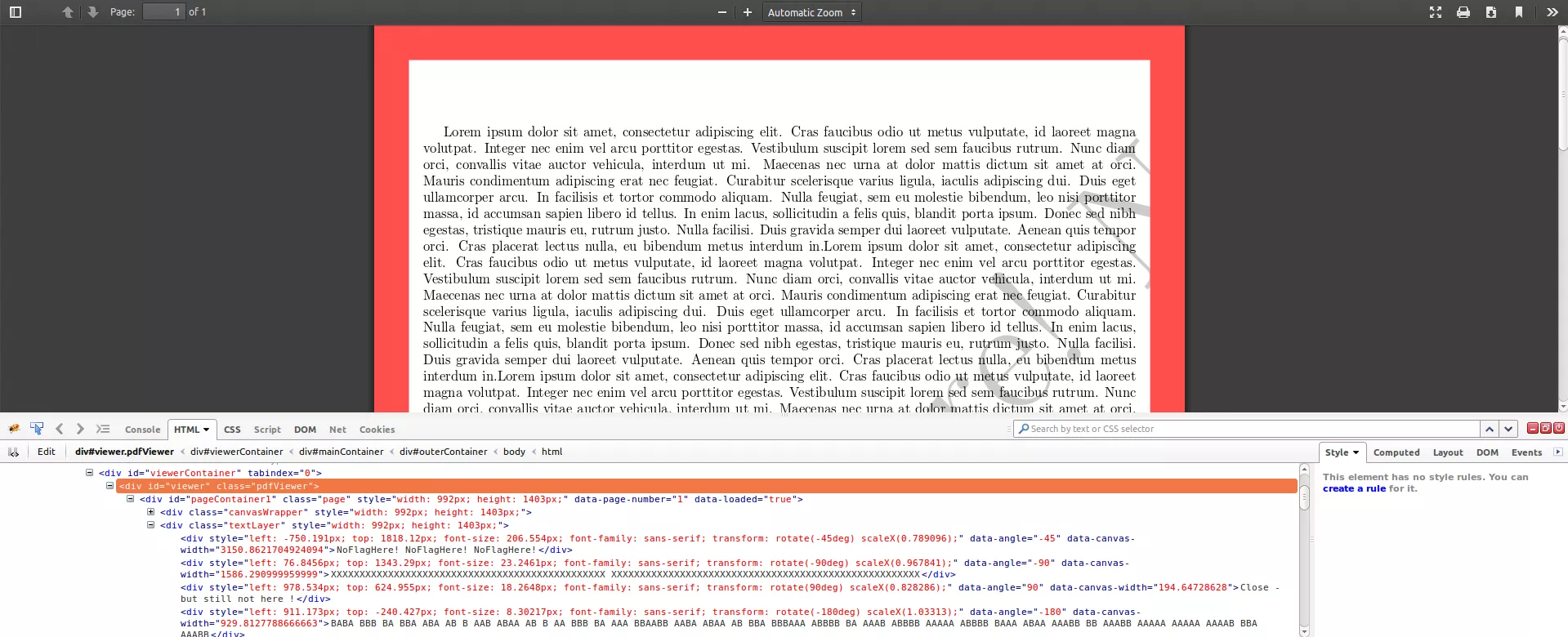CONFidence DS CTF Teaser: Stegano50
▆██▅█▇█▄▃█▆▅▄▆▁▁█▆▇█▄█▄▂▁▄▁▄▆▇▃▂▁▅▇▇▅▃▇▆▆▃▇▄██▂▆█▃▇▃▅▄▃█▇▃▇▅▅▄▇▁ « 📅 published on 06/May/2014 »
Challenge Analysis
The challenge consists a pdf file. Let's see what exiftool tells us about it:
$ exiftool stegano50.pdf
ExifTool Version Number : 9.46
File Name : stegano50.pdf
Directory : .
File Size : 38 kB
File Modification Date/Time : 2014:05:06 22:08:58+05:30
File Access Date/Time : 2014:05:06 20:41:54+05:30
File Inode Change Date/Time : 2014:05:06 13:05:07+05:30
File Permissions : rw-rw-r--
File Type : PDF
MIME Type : application/pdf
PDF Version : 1.5
Linearized : No
Page Count : 1
Page Mode : UseOutlines
Author : KeiDii
Title : polar bear during a snow storm
Subject : <| tr AB .- |>
Creator : LaTeX /o/
Producer : find mr.morse text
Keywords : Could, this, be, the, flag?, :, Tm9wZSAsIG5vdCBoZXJlIDspCg==
Create Date : 2014:03:13 22:33:50+01:00
Modify Date : 2014:03:13 22:33:50+01:00
Trapped : False
PTEX Fullbanner : This is pdfTeX, Version 3.1415926-2.5-1.40.14 (TeX Live 2013/Debian) kpathsea version 6.1.1
All attributes seem standard except for Subject, Producer and Keywords. Since the Keywords obviously hints at a flag like string which seems to be base64 encoded, the first thing I tried was to decode it:
$ echo -n "Tm9wZSAsIG5vdCBoZXJlIDspCg==" | base64 -d -
Nope , not here ;)
Well, that explains. Let's focus on Subject and Producer once again. These definitely hint towards a blob of text that might need Morse code decoding. The Subject hints towards translating A and B to dot and dash and it obviously points to the fact that the blob of text has to be all As and Bs. Let's view the pdf in Firefox via its pdf.js renderer:

There it is! A div element has the text blob we need. Let's extract and translate it as per the hint:
$ echo -n "BABA BBB BA BBA ABA AB B AAB ABAA AB B AA BBB BA AAA BBAABB AABA ABAA AB BBA BBBAAA ABBBB BA AAAB ABBBB AAAAA ABBBB BAAA ABAA AAABB BB AAABB AAAAA AAAAA AAAAB BBA AAABB" | tr AB .-
-.-. --- -. --. .-. .- - ..- .-.. .- - .. --- -. ... --..-- ..-. .-.. .- --. ---... .---- -. ...- .---- ..... .---- -... .-.. ...-- -- ...-- ..... ..... ....- --. ...--
Automation and Testing
Alright, we now have some Morse code that has to be decoded. There are several online decoders available, however, I tend to use Python for such tasks. Here is a snippet of Python code to help us with encode and decode tasks:
#!/usr/bin/env python
class morse:
def __init__(self):
# https://en.wikipedia.org/wiki/Morse_code
self.tocode = dict({
'A': '.-',
'B': '-...',
'C': '-.-.',
'D': '-..',
'E': '.',
'F': '..-.',
'G': '--.',
'H': '....',
'I': '..',
'J': '.---',
'K': '-.-',
'L': '.-..',
'M': '--',
'N': '-.',
'O': '---',
'P': '.--.',
'Q': '--.-',
'R': '.-.',
'S': '...',
'T': '-',
'U': '..-',
'V': '...-',
'W': '.--',
'X': '-..-',
'Y': '-.--',
'Z': '--..',
'0': '-----',
'1': '.----',
'2': '..---',
'3': '...--',
'4': '....-',
'5': '.....',
'6': '-....',
'7': '--...',
'8': '---..',
'9': '----.',
'.': '.-.-.-',
',': '--..--',
'?': '..--..',
'\'': '.----.',
'!': '-.-.-- ',
'/': '-..-.',
'(': '-.--.',
')': '-.--.-',
'&': '.-...',
':': '---...',
';': '-.-.-.',
'=': '-...-',
'+': '.-.-.',
'-': '-....-',
'_': '..--.-',
'"': '.-..-.',
'$': '...-..-',
'@': '.--.-.'
})
self.fromcode = dict((v,k) for (k,v) in self.tocode.items())
def to_morse(self, d):
i = list()
for c in d:
if c.upper() in self.tocode.keys():
i.append(self.tocode[c.upper()])
else:
i.append(" ")
return " ".join(i)
def from_morse(self, d):
i = list()
for c in d.split(" "):
if c in self.fromcode.keys():
i.append(self.fromcode[c])
return "".join(i)
Let's quickly use this script from within iPython and decode the Morse encoded message:
$ ipython --no-banner
>>> import morse
>>> morse = morse.morse()
>>>
>>> message = "-.-. --- -. --. .-. .- - ..- .-.. .- - .. --- -. ... --..-- ..-. .-.. .- --. ---... .---- -. ...- .---- ..... .---- -... .-.. ...-- -- ...-- ..... ..... ....- --. ...--"
>>>
>>> morse.from_morse(message)
'CONGRATULATIONS,FLAG:1NV151BL3M3554G3'
>>>
There we go!